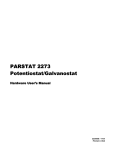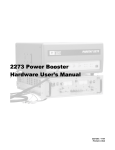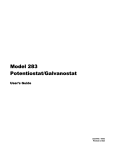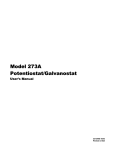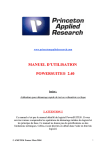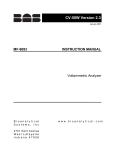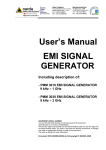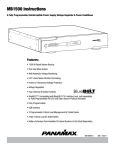Download PARSTAT 2263 Manual - Princeton Applied Research
Transcript
3$567$7 3RWHQWLRVWDW*DOYDQRVWDW +DUGZDUH 8VHU·V 0DQXDO $ 3ULQWHG LQ 86$ $GYDQFHG 0HDVXUHPHQW 7HFKQRORJ\ ,QF a/k/a Princeton Applied Research, a subsidiary of AMETEK®, Inc. :$55$17< Princeton Applied Research* warrants each instrument of its own manufacture to be free of defects in material and workmanship. Obligations under this Warranty shall be limited to replacing, repairing or giving credit for the purchase price, at our option, of any instrument returned, shipment prepaid, to our Service Department for that purpose within ONE year of delivery to the original purchaser, provided prior authorization for such return has been given by an authorized representative of Princeton Applied Research. This Warranty shall not apply to any instrument, which our inspection shall disclose to our satisfaction, to have become defective or unworkable due to abuse, mishandling, misuse, accident, alteration, negligence, improper installation, or other causes beyond our control. This Warranty shall not apply to any instrument or component not manufactured by Princeton Applied Research. When products manufactured by others are included in Princeton Applied Research equipment, the original manufacturer's warranty is extended to Princeton Applied Research customers. Princeton Applied Research reserves the right to make changes in design at any time without incurring any obligation to install same on units previously purchased. THERE ARE NO WARRANTIES THAT EXTEND BEYOND THE DESCRIPTION ON THE FACE HEREOF. THIS WARRANTY IS IN LIEU OF, AND EXCLUDES ANY AND ALL OTHER WARRANTIES OR REPRESENTATIONS, EXPRESSED, IMPLIED OR STATUTORY, INCLUDING MERCHANTABILITY AND FITNESS, AS WELL AS ANY AND ALL OTHER OBLIGATIONS OR LIABILITIES OF PRINCETON APPLIED RESEARCH, INCLUDING, BUT NOT LIMITED TO, SPECIAL OR CONSEQUENTIAL DAMAGES. NO PERSON, FIRM OR CORPORATION IS AUTHORIZED TO ASSUME FOR PRINCETON APPLIED RESEARCH ANY ADDITIONAL OBLIGATION OR LIABILITY NOT EXPRESSLY PROVIDED FOR HEREIN EXCEPT IN WRITING DULY EXECUTED BY AN OFFICER OF PRINCETON APPLIED RESEARCH. 6+28/' <285 (48,30(17 5(48,5( 6(59,&( A. Contact the Customer Service Department (865-482-4411) or your local representative to discuss the problem. In many cases it will be possible to expedite servicing by localizing the problem. B. If it is necessary to send any equipment back for service, we need the following information. 1. Model number and serial number. 5. Your telephone number and extension. 2. Your name (instrument user). 6. Symptoms (in detail, including control settings). 3. Your address. 7. Your purchase order number for repair charges (does not apply to repairs in warranty). 4. Address to which the instrument should be returned. 8. Shipping instructions (if you wish to authorize shipment by any method other than normal surface transportation). C. U.S. CUSTOMERS — Ship the equipment being returned to: Advanced Measurement Technology, Inc. 801 S. Illinois Avenue Oak Ridge, TN 37831 ATTN: Customer Service PHONE: 865-482-4411 FAX: 865-483-2133 D. CUSTOMERS OUTSIDE OF U.S.A. — To avoid delay in customs clearance of equipment being returned, please contact the factory or the nearest factory distributor for complete shipping information. Copyright © 2002, Advanced Measurement Technology, Inc. All rights reserved. *Princeton Applied Research is a registered trademark of Advanced Measurement Technology, Inc. All other trademarks used herein are the property of their respective owners. ii 7$%/(2)&217(176 Safety Instructions and Symbols . . . . . . . . . . . . . . . . . . . . . . . . . . . . . . . . . . . . . . . . . . . . . . . . . . . . . . . . . . . . . . . . . . . v Cleaning Instructions . . . . . . . . . . . . . . . . . . . . . . . . . . . . . . . . . . . . . . . . . . . . . . . . . . . . . . . . . . . . . . . . . . . . . . . . . . . . v 1. INTRODUCTION . . . . . . . . . . . . . . . . . . . . . . . . . . . . . . . . . . . . . . . . . . . . . . . . . . . . . . . . . . . . . . . . . . . . . . . . . . . . 1.1. Hardware . . . . . . . . . . . . . . . . . . . . . . . . . . . . . . . . . . . . . . . . . . . . . . . . . . . . . . . . . . . . . . . . . . . . . . . . . . . . . . 1.2. Potentiostatic Circuitry . . . . . . . . . . . . . . . . . . . . . . . . . . . . . . . . . . . . . . . . . . . . . . . . . . . . . . . . . . . . . . . . . . . . 1.2.1. Potentiostatic Mode . . . . . . . . . . . . . . . . . . . . . . . . . . . . . . . . . . . . . . . . . . . . . . . . . . . . . . . . . . . . . . . . 1.2.2. Galvanostatic Mode . . . . . . . . . . . . . . . . . . . . . . . . . . . . . . . . . . . . . . . . . . . . . . . . . . . . . . . . . . . . . . . . 1.3. Software . . . . . . . . . . . . . . . . . . . . . . . . . . . . . . . . . . . . . . . . . . . . . . . . . . . . . . . . . . . . . . . . . . . . . . . . . . . . . . . 1.4. Polarity Convention . . . . . . . . . . . . . . . . . . . . . . . . . . . . . . . . . . . . . . . . . . . . . . . . . . . . . . . . . . . . . . . . . . . . . . 1.5. Inspecting Your New Instrument . . . . . . . . . . . . . . . . . . . . . . . . . . . . . . . . . . . . . . . . . . . . . . . . . . . . . . . . . . . . 1.6. Maintenance, Service, and Support . . . . . . . . . . . . . . . . . . . . . . . . . . . . . . . . . . . . . . . . . . . . . . . . . . . . . . . . . 1.7. About This Manual . . . . . . . . . . . . . . . . . . . . . . . . . . . . . . . . . . . . . . . . . . . . . . . . . . . . . . . . . . . . . . . . . . . . . . . 1 1 1 1 2 3 3 3 3 3 2. SAFETY AND COMPONENT PLACEMENT . . . . . . . . . . . . . . . . . . . . . . . . . . . . . . . . . . . . . . . . . . . . . . . . . . . . . . 2.1. Safety Considerations . . . . . . . . . . . . . . . . . . . . . . . . . . . . . . . . . . . . . . . . . . . . . . . . . . . . . . . . . . . . . . . . . . . . 2.1.1. No Line Voltage Settings or Fuses . . . . . . . . . . . . . . . . . . . . . . . . . . . . . . . . . . . . . . . . . . . . . . . . . . . . . 2.1.2. Defects and Abnormal Stresses . . . . . . . . . . . . . . . . . . . . . . . . . . . . . . . . . . . . . . . . . . . . . . . . . . . . . . 2.2. Component Placement . . . . . . . . . . . . . . . . . . . . . . . . . . . . . . . . . . . . . . . . . . . . . . . . . . . . . . . . . . . . . . . . . . . 2.2.1. Ventilation . . . . . . . . . . . . . . . . . . . . . . . . . . . . . . . . . . . . . . . . . . . . . . . . . . . . . . . . . . . . . . . . . . . . . . . . 2.2.2. Radio Frequency Interference . . . . . . . . . . . . . . . . . . . . . . . . . . . . . . . . . . . . . . . . . . . . . . . . . . . . . . . . 2.2.3. Transient Sensitivity . . . . . . . . . . . . . . . . . . . . . . . . . . . . . . . . . . . . . . . . . . . . . . . . . . . . . . . . . . . . . . . . 5 5 5 5 5 5 6 6 3. INSTALLATION . . . . . . . . . . . . . . . . . . . . . . . . . . . . . . . . . . . . . . . . . . . . . . . . . . . . . . . . . . . . . . . . . . . . . . . . . . . . . 9 3.1. Enabling the USB Port on Your PC . . . . . . . . . . . . . . . . . . . . . . . . . . . . . . . . . . . . . . . . . . . . . . . . . . . . . . . . . . 9 3.2. Connectors and Indicators . . . . . . . . . . . . . . . . . . . . . . . . . . . . . . . . . . . . . . . . . . . . . . . . . . . . . . . . . . . . . . . . . 9 3.2.1. Rear Panel . . . . . . . . . . . . . . . . . . . . . . . . . . . . . . . . . . . . . . . . . . . . . . . . . . . . . . . . . . . . . . . . . . . . . . . 9 3.2.1.1. INPUT POWER . . . . . . . . . . . . . . . . . . . . . . . . . . . . . . . . . . . . . . . . . . . . . . . . . . . . . . . . . . . . 9 3.2.1.2. USB . . . . . . . . . . . . . . . . . . . . . . . . . . . . . . . . . . . . . . . . . . . . . . . . . . . . . . . . . . . . . . . . . . . . . . 9 3.2.1.3. SYNC ADC INPUT . . . . . . . . . . . . . . . . . . . . . . . . . . . . . . . . . . . . . . . . . . . . . . . . . . . . . . . . . 10 3.2.1.4. DAC OUTPUT . . . . . . . . . . . . . . . . . . . . . . . . . . . . . . . . . . . . . . . . . . . . . . . . . . . . . . . . . . . . 10 3.2.1.5. AUXILIARY INTERFACE . . . . . . . . . . . . . . . . . . . . . . . . . . . . . . . . . . . . . . . . . . . . . . . . . . . . 10 3.2.2. Front Panel . . . . . . . . . . . . . . . . . . . . . . . . . . . . . . . . . . . . . . . . . . . . . . . . . . . . . . . . . . . . . . . . . . . . . . 10 3.2.2.1. CELL CABLE Connector and Cable . . . . . . . . . . . . . . . . . . . . . . . . . . . . . . . . . . . . . . . . . . . 10 3.2.2.2. Indicators . . . . . . . . . . . . . . . . . . . . . . . . . . . . . . . . . . . . . . . . . . . . . . . . . . . . . . . . . . . . . . . . 11 CELL . . . . . . . . . . . . . . . . . . . . . . . . . . . . . . . . . . . . . . . . . . . . . . . . . . . . . . . . . . . . . . . . . . . . . . 11 I OVLD (Current Overload) . . . . . . . . . . . . . . . . . . . . . . . . . . . . . . . . . . . . . . . . . . . . . . . . . . . . 11 E OVLD (Voltage Overload) . . . . . . . . . . . . . . . . . . . . . . . . . . . . . . . . . . . . . . . . . . . . . . . . . . . . 11 COMM . . . . . . . . . . . . . . . . . . . . . . . . . . . . . . . . . . . . . . . . . . . . . . . . . . . . . . . . . . . . . . . . . . . . . 11 POWER . . . . . . . . . . . . . . . . . . . . . . . . . . . . . . . . . . . . . . . . . . . . . . . . . . . . . . . . . . . . . . . . . . . . 11 3.3. Connecting to the PC and Cell . . . . . . . . . . . . . . . . . . . . . . . . . . . . . . . . . . . . . . . . . . . . . . . . . . . . . . . . . . . . 11 3.3.1. Connecting to the PC . . . . . . . . . . . . . . . . . . . . . . . . . . . . . . . . . . . . . . . . . . . . . . . . . . . . . . . . . . . . . . 11 3.3.1.1. Installing the USB Driver . . . . . . . . . . . . . . . . . . . . . . . . . . . . . . . . . . . . . . . . . . . . . . . . . . . . 12 3.3.2. Connecting the Cell . . . . . . . . . . . . . . . . . . . . . . . . . . . . . . . . . . . . . . . . . . . . . . . . . . . . . . . . . . . . . . . 12 4. SPECIFICATIONS AND PINOUTS . . . . . . . . . . . . . . . . . . . . . . . . . . . . . . . . . . . . . . . . . . . . . . . . . . . . . . . . . . . . . 4.1. Electrical Specifications, Potentiostatic Circuitry . . . . . . . . . . . . . . . . . . . . . . . . . . . . . . . . . . . . . . . . . . . . . . . 4.1.1. Power Amplifier . . . . . . . . . . . . . . . . . . . . . . . . . . . . . . . . . . . . . . . . . . . . . . . . . . . . . . . . . . . . . . . . . . . 4.1.2. Differential Electrometer . . . . . . . . . . . . . . . . . . . . . . . . . . . . . . . . . . . . . . . . . . . . . . . . . . . . . . . . . . . 4.1.3. iR Compensation . . . . . . . . . . . . . . . . . . . . . . . . . . . . . . . . . . . . . . . . . . . . . . . . . . . . . . . . . . . . . . . . . 4.1.4. Current Measurement . . . . . . . . . . . . . . . . . . . . . . . . . . . . . . . . . . . . . . . . . . . . . . . . . . . . . . . . . . . . . 4.1.5. Potential/Current Control . . . . . . . . . . . . . . . . . . . . . . . . . . . . . . . . . . . . . . . . . . . . . . . . . . . . . . . . . . . 13 13 13 13 13 13 13 iii 4.1.6. Impedance Specifications . . . . . . . . . . . . . . . . . . . . . . . . . . . . . . . . . . . . . . . . . . . . . . . . . . . . . . . . . . 4.2. Physical and Power Specifications . . . . . . . . . . . . . . . . . . . . . . . . . . . . . . . . . . . . . . . . . . . . . . . . . . . . . . . . . 4.3. Standard Environmental Conditions . . . . . . . . . . . . . . . . . . . . . . . . . . . . . . . . . . . . . . . . . . . . . . . . . . . . . . . . 4.4. AUXILIARY INTERFACE Pinouts . . . . . . . . . . . . . . . . . . . . . . . . . . . . . . . . . . . . . . . . . . . . . . . . . . . . . . . . . . iv 14 14 14 14 PARSTAT 2263 Hardware User’s Manual 6DIHW\,QVWUXFWLRQVDQG6\PEROV This manual contains up to three levels of safety instructions that must be observed in order to avoid personal injury and/or damage to equipment or other property. These are: DANGER Indicates a hazard that could result in death or serious bodily harm if the safety instruction is not observed. WARNING Indicates a hazard that could result in bodily harm if the safety instruction is not observed. CAUTION Indicates a hazard that could result in property damage if the safety instruction is not observed. Please read all safety instructions carefully and make sure you understand them fully before attempting to use this product. &OHDQLQJ,QVWUXFWLRQV WARNING Using this instrument in a manner not specified by the manufacturer may impair the protection provided by the instrument. To clean the instrument exterior: Unplug the instrument from all voltage sources. Remove loose dust on the outside of the instrument with a lint-free cloth. Remove remaining dirt with a lint-free cloth dampened in a general-purpose detergent and water solution. Do not use abrasive cleaners. CAUTION To prevent moisture inside of the instrument during external cleaning, use only enough liquid to dampen the cloth or applicator. Allow the instrument to dry before reconnecting the power cord. TABLE OF CONTENTS v vi PARSTAT 2263 Hardware User’s Manual ,1752'8&7,21 The PARSTAT 2263 Advanced Electrochemical System is a potentiostat/galvanostat/frequency response analyzer (FRA) that, together with our ,PIGXVSGLIQMWXV] 7S[IV:YMXI software, comprises a simple, flexible, and extremely powerful system for performing a wide range of electrochemical techniques. The PARSTAT 2263 is controlled from any suitably equipped PC via a Universal Serial Bus (USB) interface, using one of our ,PIGXVSGLIQMWXV] 7S[IV:YMXI™ family of electrochemistry software modules — there are no user controls on the instrument itself. Calibration, operation, and experimental procedures are covered in the ,PIGXVSGLIQMWXV] 7S[IV:YMXI HTML Help Manual, available on the software Help menu. The PARSTAT 2263, together with its host PC, an electrochemical cell, and ,PIGXVSGLIQMWXV] 7S[IV:YMXI, constitutes a complete electrochemistry research system. You do not need a separate potentiostat or analyzer — the PARSTAT 2263 is a self-contained unit that combines potentiostatic circuitry with phase-sensitive detection. The PARSTAT 2263-2 The PARSTAT 2263-2 option is designed to allow the system to “float,” that is, it isolates the unit’s electrode leads from ground. This option allows you to use the PARSTAT 2263 to perform experiments on cells or working electrodes that have a ground source themselves. Examples of such “cells” are autoclaves or rebar networks in concrete. The floating option is enabled/disabled within the PowerSTAT module of ,PIGXVSGLIQMWXV] 7S[IV:YMXI with the calibration procedure (you must have the 2263-2 option to access this software feature). 1.1. Hardware The host computer provides memory, data processing, input-output, and interface capabilities. The PARSTAT 2263 electronically controls the measurement under direction of the software and the parameter values you enter from the host computer. The computer must be equipped with a USB port, and your operating system must support the USB interface. 1.2. Potentiostatic Circuitry The potentiostatic section of the PARSTAT 2263 circuitry includes: Two 16-bit digital-to-analog converters (DACs) for versatile waveform generation. Four 16-bit analog-to-digital converters (ADCs) to measure current, potential, SYNC ADC INPUT, and the potential for current interrupt. An onboard microprocessor to perform the experiment defined by the operating software. Onboard memory to store the programmed parameters and data point values. The PARSTAT 2263 operates with ,PIGXVSGLIQMWXV] 7S[IV:YMXI in either the potentiostatic or the galvanostatic mode. The potentiostatic and galvanostatic modes are described below. 1.2.1. Potentiostatic Mode In this mode, the PARSTAT 2263 controls the potential at the working electrode with respect to the reference electrode (see Fig. 1). The counter electrode is driven to the potential required (consistent with the ±20-V compliance of the control amplifier) to establish the desired working electrode potential. The range over which the working electrode potential can be controlled is ±10 V. 1 1.2.2. Galvanostatic Mode In galvanostatic operation, the PARSTAT 2263 controls the current between the counter and working electrodes at the specified fraction of the selected current range (up to the maximum of 2× the current range; see Fig. 2). The counter electrode is driven to the potential required (consistent with the ±20-V compliance of the control amplifier) to establish the desired cell current. The reference electrode is not used in the control loop, but is usually used to measure the potential at some point in the electrochemical cell. Fig. 1. Potentiostat-Mode Block Diagram. Fig. 2. Galvanostat-Mode Block Diagram. 2 PARSTAT 2263 Hardware User’s Manual 1.3. Software The PARSTAT 2263 is fully compatible with our ,PIGXVSGLIQMWXV] 7S[IV:YMXI family of electrochemistry research and development tools. While the software operates under all 32-bit Microsoft® Windows® operating systems, the PARSTAT 2263 requires a system that supports the USB interface. 1.4. Polarity Convention The PARSTAT 2263 hardware follows the American polarity convention. Positive current is cathodic; that is, a current is defined as positive if reduction is taking place at the working electrode. Negative current is anodic; that is, a current is defined as negative if oxidation is taking place at the working electrode. If the working electrode is driven positive with respect to the equilibrium potential, the resulting current is anodic. If the electrode is driven negative with respect to the equilibrium potential, the resulting current is cathodic. In complex electrochemical systems, there may be more than one equilibrium system. Where this is the case, either polarity with respect to the equilibrium potential could give rise to anodic or cathodic current, according to the system’s characteristics. 1.5. Inspecting Your New Instrument As soon as you receive your new PARSTAT 2263, inspect it for shipping damage. If any damage is noted, immediately notify Princeton Applied Research and file a claim with the carrier. Save the shipping container for possible inspection by the carrier. WARNING If your instrument has been damaged, its protective grounding may not work. Do not operate damaged equipment! Tag it to indicate to a potential user that it is unsafe to operate. 1.6. Maintenance, Service, and Support The PARSTAT 2263 has been designed for optimum reliability and requires no periodic maintenance. There are no user-serviceable parts in this instrument. Breaking the seal by opening the cover will void your warranty! Contact the factory service department or the affiliate in your area if your unit needs service (see the Warranty on page ii for more information). Remember that our worldwide staff continues to support you after you have purchased your instrument. We provide top-quality service, applications support, and a variety of helpful information in the form of application notes, technical notes, and training materials. For more information, visit our website at www.princetonappliedresearch.com. 1.7. About This Manual Chapter 2 describes recommended safety precautions for operating this instrument, including the provision of adequate ventilation. It also tells how to deal with transients on the power line, and discusses the unlikely possibility of the instrument causing radio-frequency (RF) interference. Chapter 3 shows you how to set up your hardware. It describes the functions of the connectors and indicator lights, and shows how to connect the PARSTAT 2263 to the host computer and test cell. Chapter 1 — INTRODUCTION 3 Chapter 4 gives the physical and electrical specifications of the PARSTAT 2263, including the AUXILIARY INTERFACE connector pinouts. As noted above, the PARSTAT 2263 is completely computer controlled; operation and experimental procedures are covered in the ,PIGXVSGLIQMWXV] 7S[IV:YMXI HTML Help Manual. 4 PARSTAT 2263 Hardware User’s Manual 6$)(7<$1'&20321(17 3/$&(0(17 This chapter tells you the safety precautions to use when operating the PARSTAT 2263. Please be sure to read them. It also includes some suggestions on placement of your system components, and information on possible RF interference and transient sensitivity. 2.1. Safety Considerations 2.1.1. No Line Voltage Settings or Fuses The PARSTAT 2263 automatically detects the correct line voltage and frequency. The dc power supply is self-protecting and has no user-serviceable fusing. Simplicity itself! 2.1.2. Defects and Abnormal Stresses WARNING If your instrument has been damaged, its protective grounding may not work. Do not operate damaged equipment! Tag it to indicate to a potential user that it is unsafe to operate. The PARSTAT 2263’s ground protection is likely to be impaired if, for example, the instrument: Shows visible damage. Fails to perform the intended measurement. Has been subjected to prolonged storage under unfavorable conditions. Has been subjected to severe transport stresses. The instrument should not be used until its safety has been verified by qualified service personnel. 2.2. Component Placement Before assembling the system, give some thought to component placement. You will of course need convenient access to the computer keyboard and, if applicable, the printer. Depending on the application, you may also need to connect and disconnect the cell leads regularly. NOTE The ac-dc converter should be placed as far as possible from the experimental cell and cell leads. When you’re satisfied that the system is ready to install, connect the units according to the instructions in Chapter 3. NOTE The standard system does not include an electrochemical cell. You must supply a suitable cell and electrodes. 2.2.1. Ventilation The PARSTAT 2263 specifications apply at the nominal line voltage ±10% and at a temperature of 25(C (77(F) unless otherwise noted. Ambient temperature must not exceed 50(C (122(F). See Section 4.3 for more detailed environmental specifications. To maintain a safe operating temperature, allow some free space (minimum 10 cm) at either side of the PARSTAT 2263 for adequate air circulation. Moreover, there must be adequate 5 circulation between the spaces at the sides of the instrument and the ambient laboratory air. In a typical benchtop installation, these requirements are satisfied with a large safety margin. 2.2.2. Radio Frequency Interference In a typical application, it is unlikely that the PARSTAT 2263 will act as a source of noticeable RF interference. However, when operated near particularly sensitive equipment, interference from the PARSTAT 2263 could be a problem. Following is a discussion of steps you can take to minimize that interference. Interference below about 10 MHZ is most likely to be caused by RF currents flowing in the input and output cables or in the power line cord. Because the PARSTAT 2263 uses an internal ac-dc power supply that meets CISPR22 Class B for conducted and radiated emissions, the ac line cord and the dc power cable to the instrument are unlikely to be sources of RF interference. If excessive noise pickup is present, check that the external power supply is not near the electrochemical cell or cell cable. If this does not eliminate the problem, try decoupling the power line with an external filter. At frequencies below 100 kHz, an external isolation transformer could be helpful. WARNING To reduce the risk of potentially dangerous electrical shock, only a qualified service technician should perform this work, and then only with the instrument disconnected from all sources of power. At frequencies above 10 MHZ, these measures may not suffice to prevent radiation from being a problem, particularly at VHF frequencies. Additional measures will then be required. Shielding is generally effective. A suitable shield can be constructed using metal foil, wire screening, or similar materials. Once the instrument is completely surrounded by the shield (taking care not to unduly restrict ventilation), the only additional requirement is to install low-pass filters where lines pass through the shield (all openings through the shield should be as small as possible). A capacitor between a line and the shield can function as a suitable low-pass filter. The leads of the capacitor should be as short as possible. We suggest using coaxial feedthrough capacitors. In the case of a signal lead, it is essential that the capacitor’s value be such as to attenuate the interference frequencies without unduly attenuating critical frequency components of the signal itself. NOTE Keep the filter capacitor leads short! Long leads establish sizable ground loops and may additionally act as radiating antennae. Coaxial cables are a special case in that the cable shield acts as an extension of the enclosure shield. This being the case, the filter can be counted in a shielded box fitted with coaxial connectors without undue concern for keeping the box extremely close to the enclosure. If more convenient to do so, it can be located at some distance from the enclosure as long as the integrity of the coaxial shield is maintained. The preceding techniques are extraordinary measures that should be required only in unusual cases. If they are applied with care, RF interference should be reduced to an acceptably low level in all but the most critical applications. Contact the Customer Service Department for advice in the case of a problem that does not yield to these measures. 2.2.3. Transient Sensitivity Princeton Applied Research instruments are designed and constructed to ensure normal operation in the presence of moderate transient levels. Although these provisions are sufficient for operation in most places where this equipment is used, it is certainly possible for transient 6 PARSTAT 2263 Hardware User’s Manual levels in particular environments to be so severe that they make reliable operation uncertain. There are three general types of high-level transients: 1. Static Discharge — Transients from this source generally affect input or output circuits. Input circuits that include MOS field-effect transistors to achieve a high input impedance are particularly susceptible to damage from this source. Damage typically occurs when the charge built up on a user’s body discharges into an input or output connector as a connection is being made. Among the factors determining the tendency for charges to build are the kind of clothing fabrics worn, shoe materials, and the materials in the floor or floor covering. 2. High-Level Transients Generated Internal to the Place of Use — Such transients almost always enter the instrument via the line cord. Possible sources include heavy-duty electric motors, rf equipment, lasers, diathermy machines, arc welders, spark chambers, and others. 3. Lightning — Transients caused by lightning almost always enter the instrument via the line cord. Static discharge problems can sometimes be avoided by judiciously selecting the floor covering in the work area. The simplest approach to the problem is to discharge your body by touching a grounded metal object just before touching the instrument, particularly when making connections to the cell. External line-transient filters can generally suppress transients that enter the instrument via the line cord. A suitable transient suppressor is available from Princeton Applied Research. Various kinds of power-line conditioners are also commercially available. Chapter 2 — SAFETY AND COMPONENT PLACEMENT 7 8 PARSTAT 2263 Hardware User’s Manual ,167$//$7,21 This chapter describes the PARSTAT 2263 connectors and indicators; and shows you how to connect it to the host PC, electrochemical cell, and other equipment you may wish to use with it. The pinouts for the AUXILIARY INTERFACE connector are listed in Section 4.4. 3.1. Enabling the USB Port on Your PC Some PC manufacturers ship their PCs with the USB port disabled. Before trying to use the PARSTAT 2263, make sure the USB port is enabled. To do this, go to Windows Settings, Control Panel, Systems, and click on the Hardware tab. On the hardware tab, click on the Device Manager button. At the bottom of the list it should show that the "Universal Serial Bus controller" is present. If not, go to your PC's BIOS setup and enable the USB port. 3.2. Connectors and Indicators 3.2.1. Rear Panel Figure 3 shows the rear panel of the PARSTAT 2263. Fig. 3. PARSTAT 2263 Rear Panel. 3.2.1.1. INPUT POWER This 5-pin circular DIN receptacle mates with the power cable from the ac-dc power supply. The PARSTAT 2263 input voltage range is 11–17 V. Nominal input voltage is 15 V dc with 2.5 A nominal current at 15 V. 3.2.1.2. USB Attach the supplied USB cable to this connector and to the USB connector on the PC. You can connect to and disconnect from the PC without shutting down or restarting Windows or ,PIGXVSGLIQMWXV] 7S[IV:YMXI. 9 NOTE In ,PIGXVSGLIQMWXV] 7S[IV:YMXI, when you connect or power on the PARSTAT 2263, you must close the current experiment then use the software’s Search for Instruments command or the PowerSTAT potentiostat control module to establish communications with the PARSTAT 2263. See the ,PIGXVSGLIQMWXV] 7S[IV:YMXI HTML Help Manual. 3.2.1.3. SYNC ADC INPUT This BNC allows you to monitor an auxiliary signal in the ±10-V range with 16-bit resolution. This signal is monitored synchronously with the E and I channels. 3.2.1.4. DAC OUTPUT Rear-panel BNC delivers a precise dc voltage in the ±10-V range. This output can be used to control the rotation speed of rotating disk electrodes (RDEs). 3.2.1.5. AUXILIARY INTERFACE This DB9 female connector provides several functions including the signals required to drive a Model 303A Static Mercury Drop Electrode. If using a Model 303A, you must connect the electrode to the AUXILIARY INTERFACE connecter via the Model 507 Interface. AUXILIARY INTERFACE can also turn the Model 616 Rotating Disk Electrode on and off with the STIR signal issued within ,PIGXVSGLIQMWXV] 7S[IV:YMXI. See Section 4.4 for the pin assignments. 3.2.2. Front Panel The PARSTAT 2263 front panel is shown in Fig. 4. Fig. 4. PARSTAT 2263 Front Panel. 3.2.2.1. CELL CABLE Connector and Cable The cell cable (part no. 223500) connects to the 10-pin CELL connector on the front panel via a LEMO-style connector. The connector is keyed so it can only be inserted the correct way. To connect it, grasp it by the grooved sleeve, turn it so the red dot aligns with the red mark on the CELL connector (this will ensure that the key aligns with the keyway), and press it into place. To disconnect it, grasp the grooved sleeve and pull straight out. At the other end of the cable are five color-coded leads. The color codes are: 10 Green: Working electrode lead Red: Counter electrode lead White: Reference electrode lead PARSTAT 2263 Hardware User’s Manual Gray: Sense electrode lead Black: Ground In both potentiostatic and galvanostatic operation, the RED pin plug connects to the counter electrode and the GREEN pin plug connects to the working electrode. The reference electrode (WHITE) plugs directly into the pin-jack socket and the black clip is ground. The GRAY lead is the sense lead and connects to the working electrode. The use of the black lead depends on a number of factors. It is not ordinarily used with the PARSTAT 2263, although it is available if needed for special purposes such as supplying ground to a shield screen surrounding the cell. Potentials as high as ±20 V at currents as high as 200 mA may be present at the counter electrode lead of the cell cable. The CELL indicator should always be off (unlit) when making the cell connections, as well as when the cable leads are being examined or disconnected. 3.2.2.2. Indicators CELL This LED lights when the internal cell relay is closed. The cell relay is controlled by the host PC. I OVLD (Current Overload) The I OVLD LED lights if the working electrode current exceeds 2× the full-scale current range. This does not mean that the cell control loop is out of control. For example, suppose the PARSTAT 2263 has been programmed to establish a potential of +0.752 V and that under the established conditions a cell current of 0.5 mA occurs. If the current range is 2 µA, 20 µA, or 200 µA, the current-monitoring circuits will be driven to the limit and the I OVLD indicator will light even though the cell is still controlled at +0.752 V. E OVLD (Voltage Overload) Unlike the I OVLD indicator, a lighted E OVLD indicator always means that the cell control loop is out of control. That is, the control amplifier has reached its maximum compliance voltage of ±20 V, and the potential of the working electrode with respect to the reference electrode is not as programmed. This could result from a connection error (open cell connection), an electrode problem, an unacceptably high solution resistance, or an instrument problem. COMM This indicator lights when the PARSTAT 2263 and the computer are communicating. POWER This indicator lights when the PARSTAT 2263 is powered on. 3.3. Connecting to the PC and Cell This section tells you how to connect the PARSTAT 2263 to the host PC and electrochemical cell, and to other equipment you may wish to use with it. WARNING For operator and equipment safety, power to all instruments should be off when connecting or disconnecting cables. 3.3.1. Connecting to the PC The PARSTAT 2263 is shipped with a standard USB cable. Connect it between the rear-panel USB connector and a USB port on the PC. As noted above, you can connect to and disconnect from the PC without shutting down or restarting Windows or ,PIGXVSGLIQMWXV] 7S[IV:YMXI, however, see the note in Section 3.2.1.2. Chapter 3 — INSTALLATION 11 3.3.1.1. Installing the USB Driver The first time the PARSTAT 2263 is connected to the host PC and powered on, Windows will display a Found New Hardware message, then ask you to load the USB driver file, ezusb.sys. To do this, insert the PARSTAT 2263/,PIGXVSGLIQMWXV] 7S[IV:YMXI CD-ROM supplied with the instrument. On the Windows Taskbar, click on Start, Run. In the Run dialog, click on Browse, then go to the CD-ROM. Double-click on the \disk1 folder for any one of the ,PIGXVSGLIQMWXV] 7S[IV:YMXI modules (for instance, PowerCORR). Double-click on the ezusb.sys file, then click on OK. 3.3.2. Connecting the Cell To connect the cell cable (part no. 223500) to the PARSTAT 2263: 1. Make sure the POWER switch is off. 2. Grasp the connector on the cell cable by the grooved sleeve, turn it so the red dot aligns with the red mark on the CELL connector, and press it into place. (To disconnect the cell cable connector, grasp the grooved sleeve and pull straight out.) 3. Assemble the electrochemical test cell and prepare it with the test solution. 4. Connect the color-coded leads on the cell cable to the electrodes in the test cell as described in the following steps. 5. In both potentiostatic and galvanostatic operation, connect the red lead to the counter electrode and the green and gray leads to the working electrode. The reference electrode plugs directly into the pin jack (white) and the black clip is ground. An accessory kit is provided to convert the pin plugs to alligator clips, should you need them for your setup. The polarity of the potential at the counter electrode will be opposite the “applied potential.” This is necessary to establish the correct polarity relationship at the working electrode versus the reference electrode. Use of the black (ground) lead depends on a number of factors. In most cases it is not used, although it is available if needed for a special purpose such as providing ground to a shield or screen surrounding the cell. CAUTION Take care that the leads do not accidentally short together. Because the black ground lead is often unused, it tends to be overlooked. Because of this, an accidental short involving this lead is usually more of a problem than for the other leads. 6. Other configurations and connections — If your cell is a two-terminal connection (i.e., a battery or resistor) connect both the green (working) and gray (sense) leads to either the anode or cathode, and both the red (counter) and white (reference) leads to the remaining cathode/anode. There are some applications for which a four-electrode configuration is required. In this case, the sense electrode serves as a second reference electrode, useful for controlling the potential between the reference and sense (for instance, in controlling the potential across a membrane in an H-cell setup). 7. After all other connections to the PARSTAT 2263 are completed, you can turn on power to the instrument. 12 PARSTAT 2263 Hardware User’s Manual 63(&,),&$7,216$1'3,12876 4.1. Electrical Specifications, Potentiostatic Circuitry 4.1.1. Power Amplifier Compliance Voltage ±20 V Maximum Current ±200 mA Rise Time <1 µs (no load) Slew Rate >1 V/µs (no load) System Performance Minimum Time Base 20 µs Minimum Potential Step 2.5 µV Noise and Ripple <50 µV rms typical Minimum Current Range 200 nA (hardware) Minimum Current Range 2 nA with 50X gain Minimum Current Resolution 120 fA 4.1.2. Differential Electrometer Input Bias Current <50 pA at 25°C, typically <20 pA Max. Voltage Range ±10 V maximum Input Voltage Differential ±10 V Bandwidth 3 dB @ >9 MHz Common Mode Rejection >60 dB at 100 Hz >50 dB at 100 kHz Input Impedance >1010 in parallel with <10 pF 4.1.3. iR Compensation Positive Feedback Range: 20 M to 20 depending on current range Current Interrupt 16-bit DAC potential error correction 4.1.4. Current Measurement Ranges 7 decades, 200 mA to 200 nA Accuracy (dc) 20 µA to 200 mA <0.4% full scale 200 nA and 2µA ranges <0.5% ±5 nA full scale Frequency Response (small signal) 2 mA Range 3 dB at >1 MHz, 1k source impedance 20 µA Range 3 dB at >100 kHz, 100k source impedance 4.1.5. Potential/Current Control Digital/Analog Converters (DACs) Bias DAC Resolution 16 bits Range (potentiostat) ±10 V Range (galvanostat) ±100% of full-scale current Modulation DAC Resolution 16 bits Range (potentiostat) ±10 V Range (galvanostat) ±100% 13 4.1.6. Impedance Specifications Frequency Range 10 µHz–1 MHz 4.2. Physical and Power Specifications Computer Interface Universal Serial Bus (USB). Weight 7.5 kg (16.5 lbs) Dimensions 36.8 cm W × 40.6 cm D × 15.3 cm H (14.5 in. × 16 in. × 6 in.) Power Requirements PARSTAT 2263 11–17 V dc at 50 W nominal External ac-dc converter 90–264 V ac, 47–63 Hz, 120 W maximum 4.3. Standard Environmental Conditions This equipment is designed to meet or exceed the requirements of the following standards: LVD: EN61010-1: 1993, Amendment 2 EMC: 61326: 1998 Emissions EN55011: 1991, Group I, Class A Immunity: IEC 61000-4-2: 1995, ESD IEC 61000-4-3: 1995, EM Field IEC 61000-4-4: 1995, Burst IEC 61000-4-5: 1995, Surge IEC 61000-4-6: 1995, Conducted RF 4.4. AUXILIARY INTERFACE Pinouts 14 Pin Signal Function 1 Ground 2 TRIG IN This signal is issued if the Ignore external WAIT line option has been selected on the Expert Options page in the New Experiment Wizard. 3 DISPENSE When using the PARSTAT 2263 with a Model 303 or 303A Static Mercury Drop Electrode (SMDE) via a Model 507 Interface, this signal causes the electrode to perform a DISLODGE/DISPENSE operation on command from the host PC (set on the Cell Definition page of the ,PIGXVSGLIQMWXV] 7S[IV:YMXI New Experiment Wizard). 4 TRIG OUT A TTL trigger output is provided on this line if the Issue pulse out before starting option has been selected on the Expert Options page in the ,PIGXVSGLIQMWXV] 7S[IV:YMXI New Experiment Wizard. 5 BIT 0 IN Not used. 6 — Not used. 7 BIT 0 OUT Not used. PARSTAT 2263 Hardware User’s Manual Pin Signal Function 8 PURGE When using a Model 303 or 303A SMDE via a Model 507 Interface, this signal controls the electrode’s PURGE function in response to commands from the host PC (set on the PreScan Definition page of the ,PIGXVSGLIQMWXV] 7S[IV:YMXI New Experiment Wizard). 9 STIR This signal controls the Model 303 or 303A’s STIR function in response to commands from an external computer (set on the Cell Definition page of the ,PIGXVSGLIQMWXV] 7S[IV:YMXI New Experiment Wizard). It is assumed that the electrode is being used with a Model 305 stirrer. Chapter 4 — SPECIFICATIONS AND PINOUTS 15 16 PARSTAT 2263 Hardware User’s Manual






















